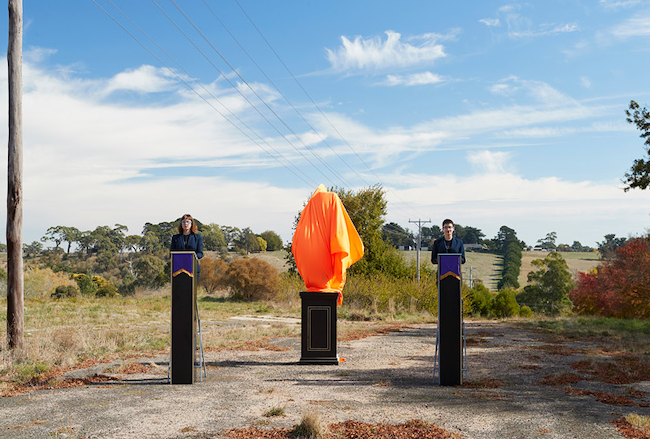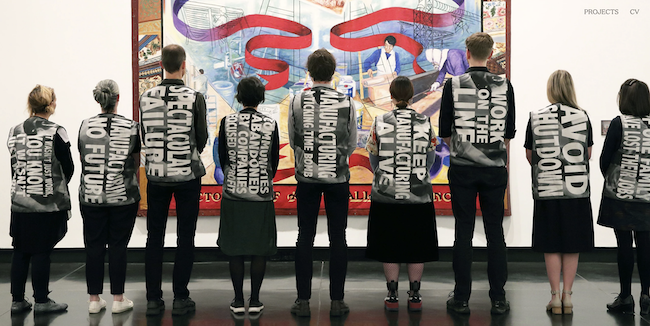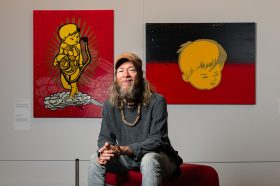Amy Scaife’s protest performance Human Cost at the Tate Britain’s Duveen gallery in 2011. Courtesy Liberate Tate
When one thinks of the art of protest it is hard to go past John Lennon and Yoko Ono’s 1969 bed-in against the Vietnam War or the balaclava’d punk divas of Pussy Riot, who came to the fore in 2012 with a protest performance in Moscow’s Cathedral of Christ the Savior, directed at the Church’s support for Vladimir Putin.

Image Pussy Riot 2012 with a protest performance in Moscow’s Cathedral of Christ the Savior, courtesy the artists
These are artworks that not only have a political intent, but go beyond visual commentary to using art as a form of direct action.
For example, while a photograph of Chinese dissident artist Ai Weiwei’s raised finger to Tianamen, or an installation of impeccably carved marble refugee life jackets scattered in a gallery by Alex Seton call for the viewer’s consideration on geo-political issues, it is an action like Banksy’s last year, when his work Girl With Balloon was automatically shredded after being sold for £1m by Sotheby’s, that demonstrates this escalated action by artists.
For Banksy it was not only statement against the absurdity of the bloated secondary art market, but a real disruption to it.
This kind of physical investment in protest by artists has escalating in recent years. For example, consider American Photographer Nan Goldin and her group PAIN (Prescription Addiction Intervention Now), who have staged actions at the Metropolitan Museum of Art, the Guggenheim, the Smithsonian, and Harvard University’s art museums against donations accepted from the Sackler family, an empire founded on prescription opioids.
While in the UK, the artist collective Liberate Tate (pictured top) has targeted the TATE with over 20-actions described as ‘unsanctioned performative interventions’ that combine action and aesthetics in resistance to the art museum’s relationship with oil giant BP.
In Australia, it was a group of artist who boycotted the 2014 Biennale of Sydney in response the principal sponsor’s links to the asylum seeker detention industry, and likewise in Melbourne, artists protested the National Gallery of Victoria (NGV) over its contracted security firm, also having offshore detention links.
As part of that action (staged December 2017), three artists – Gabrielle de Vietri, Candice Breitz and Rafael Lozano-Hemmer showing in the inaugural NGV Triennial – altered the content of their works or changed their titles to Wilson Must Go in protest to the contract. It resulted in those relationships being withdrawn.
Art-led protests are on the rise
Art made in protest is arguably on the rise in our neoliberal, post-truth era, and Australian artists have equally used their art making as a platform for dialogue and, ideally, change.
‘Artists are clearly using geo-politics as muse, however there is a difference between adding to a flow of conversation and actively pushing for change,’ writes Rebecca Gallo. ‘They are trying to flip their work over from being politically engaged and politically motivated, to being politically active.’
Making the point, the often viewed bastion of “the contemporary art moment”, New York’s Whitney Museum presented the important exhibition last year, An Incomplete History of Protest, while in Australia Melbourne University’s Potter Gallery presented State of the Union exhibition (2018), examining the role of art in the union movement and Artspace in Sydney launched 52 Artists 52 Actions, an online initiative that shared creative protests on Instagram.
And this month, Aboriginal artist Richard Bell will take his project of protest, Embassy, to the Venice Biennale. Clearly, active protest through art has expanded well beyond ‘the velvet gloved thinker’.
Here are nine examples of art inspired by protest to celebrate this May Day.

Unveilings by Make or Break, 2018 (Kyneton Contemporary Art Triennial, Victoria). Image: Zan Wimberley via Make or Break.
9. Toppling, defacing, or veiling statues
Whether it’s Joseph Stalin, Saddam Hussein, or Captain Cook, statues are often understood to stand for more than just the individuals they portray. Toppling a statue is a universal image symbolising the end of an oppressive regime, and recent years have witnessed many conversations around the world on what to do with monuments that celebrate unsavoury histories. Many cities in the southern states of the US have removed Confederate monuments, while across Australia, artists and protestors have responded to colonial monuments with a diversity of tactics: spray paint proclaiming “no pride in genocide”, counter-memorials
In Landmark (2005), an upside-down statue of governor Charles La Trobe that was displayed near Melbourne’s Parliament House in 2006, artist Charles Robb challenged the merit of traditional monuments and called into question ‘the relevance and authority of this predominantly European visual language’. Last year at Kyneton Contemporary Art Triennial, New South Wales-based duo Make or Break (Rebecca Gallo and Connie Anthes) presented Unveilings, a site-specific performance work that involved shrouded monuments and a community consultation process around what should be memorialised.
8. CHASING ASYLUM
This 2016 documentary film told the story of Australia’s inhumane treatment of asylum seekers and refugees, examining the human, political, financial and moral impact of current and previous policy. Directed by Academy Award-winning Australian producer Eva Orner (Taxi to the Dark Side), Chasing Asylum took hidden cameras inside Australia’s detention centres on Nauru and Manus Island, producing never-before-seen images that revealed the personal impact of sending those in search of a safe home to languish in limbo.
7. ESCAPE FROM WOOMERA
Developed in 2003-04, this point-and-click video game put the players in the shoes of Mustafa, an Iranian asylum held in mandatory detention at Woomera Immigration Reception and Processing Centre in South Australia. As the name of the game suggests, Escape from Woomera was a provocative piece of art activism developed with a $25,000 grant from the Australia Council.
The game’s blunt criticism of Australian immigration policy and the fact that it had received federal funding created a major controversy, with the likes of Immigration Minister Philip Ruddock criticising both the game and the Autralia Council’s decision to fund it.
Sixteen years later, the game’s near-mythological status will be explored in an upcoming event at Melbourne’s Arts House in May. Return to Escape from Woomera is billed as ‘a turbo-charged and retro-fitted evening of live gaming, performance, discussion and debate’ featuring gameplay alongside human rights advocates, refugees and the game’s original makers, exploring the ongoing significance of this singular cultural intervention.

Image courtesy Peter Drew.
6. PETER DREW: SEEKING AUSTRALIA
Peter Drew could be described as a graphic poster artist. He first gained national attention in 2016 after creating a series of street posters aimed at starting a conversation about refugees and immigration.
He travelled across Australia sticking up 1000 poster of Monga Khan – one of thousands of people, Cameleers and traders, who applied for exemptions to the White Australia Policy, because they were considered essential to Australian’s growing economy.
He followed that campaign in 2017, with the poster series Real Australians Seek Welcome focusing on the issues of Aboriginal languages and traditional ownership of land, while in 2018 a series that takes seven dislocated ideas to try to create meaning in our increasingly fractured world.

Kay Abude Onshore Production 24 July – 28 October 2018, Digital print on textiles, sewn into work vests and performed by the gallery attendants at The Ian Potter Museum of Art, The University of Melbourne for the exhibition State of the Union; image kayabude.com
5. Art for Equal Rights
The exhibition State of the Union, presented by the Ian Potter Museum of Art last year, was an exhaustive look at the art of unionism and protest for equal rights. Ray Edgar writes: “Art is a weapon” was the motto of the Australian Workers Art Clubs in the 1930s and ’40s. Artists such as Noel Counihan took to the coal mines to expose harsh, unhealthy working conditions.’
Edgar asks: ‘Does a museum show relegate the revolution to artefact or does it make the show itself a revolutionary action?’
This historical survey, however, was updated with a very contemporary protest intervention. Gallery staff work clothing during the exhibition created by artist Kay Abude – a line of clothing bearing slogans highlighting the offshore manufacturing of classic Australian brands such as Bonds.
Another example was documentation by activist artists Sam Wallman and Nicky Minus, who travelled to Shepparton (VIC) collaborating with migrant farm workers painting and translating slogans as a protest artwork. Wallman and Minus use a range of media including murals, zines and even teatowels to tell stories of equal rights campaigns.
It was the collateral around this exhibition that demonstrated how protest in the gallery today is more than just art on the wall.

Ms Saffaa’s work as seen in Landless Bodies at Casula Powerhouse October 2018; photo artshub courtesy the artist
4. I AM MY OWN GUARDIAN – PROTESTING WOMEN’S RIGHTS
Also turning to posters, Sydney-based artist Ms Saffaa has use her art in protest for the Saudi Arabia women’s rights movement. Combining a street art actions and paste ups using graffiti style calligraphy in LGBTQI colours, and portraits of women’s rights activists, Manal Al-Sharif and Samar Badawi, are shown wearing the traditional male head-dress, the shemagh.
The Sydney-based artist uses social media to bolster her street art protests, carrying the hashtag #iammyownguardian They are a direct call to action against the retraction of women’s rights. Saffaa’s protest gained traction after the July 2016 Human Rights Watch report, which was critical of the laws prohibiting a Saudi woman from travelling, marrying or even leaving prison without the permission of a male guardian.
3. WHO’S AFRAID OF THE WORKING CLASS – MELBOURNE WORKER’S THEATRE
Australia has a long history of radical theatre – work inspired by the spirit of protest. As Connie Healy notes in her article, ‘Women In Radical Theatre In Brisbane’, such a tradition includes the Roving Reds Revue Company during the Great Depression of the early 1930s; playwrights such as Mona Brand, Dymphna Cusack, Catherine Duncan and Betty Roland; and the work staged by the Communist-inspired New Theatre movement (founded in Sydney in 1932 and Melbourne in 1936).
That tradition echoed down the years in works including John Romerill’s 1969 agit-prop production for The Pram Factory, Mr Big the Big Big Pig and more recently, version 1.0’s ‘powerful – and powerfully funny – deconstruction of history, memory and narrative,’ CMI (A Certain Maritime Incident), exploring both the lies of ‘children overboard’ and the tragedy of the SIEV-X.
Perhaps one of the most powerful works inspired by the spirit of protest and written for the stage in recent decades is Melbourne Workers Theatre’s Who’s Afraid of the Working Class? Jointly written by Andrew Bovell, Christos Tsiolkas, Patricia Cornelius and Melissa Reeves and premiering at Melbourne’s Trades Hall in 1999, the play was a powerful condemnation of neoliberalism and those it left behind, caustic, polemic, bruising, beautiful and utterly unforgettable.

Fossil fuels + the Arts (2019), interactive network map, courtesy of A Centre for Everything
2. A CENTRE FOR EVERYTHING
Founded in 2012 by artists Will Foster and Gabrielle de Vietri, Melbourne collective A Centre for Everything ‘seek to directly address and deconstruct the barrier between art that is politically engaged, and that which is politically active’, describes their website. They do that through workshops, interventions, performances, demonstrations, critiques and meals.
Spearheading both the Transfield Biennale of Sydney boycott and NGV Wilson protests, their most recent project, Maps of Gratitude, Cones of Silence and Lumps of Coal (2019), sketches out the connections between the fossil fuels industry and the arts in Australia, through a live-data map.
The project also present a replica of mining magnate Gina Rinehart’s public sculpture, Our Future, a 30-ton iron ore boulder inscribed with a poem lamenting mining taxes. Built with retractable handles and wheels, A Centre for Everything’s object will double as a portable ice cream cart from which ‘ice coal’ was served during the exhibition at Monash University Museum of Art (MUMA).
It was presented as part of the gallery’s international group exhibition Shapes of Knowledge in relation to global shifts in art and activism (9 February – 13 April 2019).

Richard Bell, Embassy installation 2016, 20th Biennale of Sydney installation view. Courtesy of the artist and Milani Gallery Brisbane.
1. Richard Bell’s Embassy PROTESTS IN VENICE
Ann Stephen explains: ‘Half a century ago, the 1969 Venice Biennale was rocked by student demonstrations, street battles and strikes at the height of the American war in South East Asia. Artists boycotted the official events, and the Giardini’s exhibition gardens were closed down by police following threats to torch the pavilions. Many of the exhibiting artists withdrew works, pavilions were closed and the official prizes were abandoned. At the time, the visionary museum director Pontus Hulten saw these circumstances as positive.’
In a matter of days, Venice will again be the site for an artist protest. Aboriginal artist Richard Bell will stage EMBASSY: BELL Invites… an activist intervention and mobilisation of the “original” Aboriginal Tent Embassy, established on the lawns of Australian Parliament in Canberra in January 1972.
In Venice, Bell proposes to use the alternative site of Certosa, an island some distance from the official Giardini Park.
‘The move represents not only a self-imposed exile but engages in a form of Indigenous diplomacy, in collaboration with Clothilde Bullen, who is to curate a public programme of conversations with selected First Nation artists, cultural producers and activists,’ explained writer Alice-Anne Psaltis.
Since 2013 Bell has travelled EMBASSY across many sites, including the Moscow Biennale (2013), Performa, New York (2015); the Jakarta Biennale; the Sonsbeek International in Amsterdam; the Stedelijk Museum; and the 20th Biennale of Sydney in 2016; and the New School, New York in 2017.
By erecting EMBASSY at strategic locations in biennales and exhibitions, Bell usurps the “power brokers” to host a public programme of conversations and debates.
Bell crowdfunded his trip to Venice. He was one of the artists officially shortlisted as Australia’s representative, with a proposal to wrap the pavilion in chains.
By Gina Fairley, with additional contributions by Richard Watts, Rochelle Siemienowicz and Jinghua Qian.





